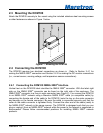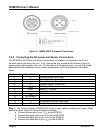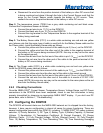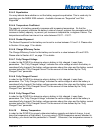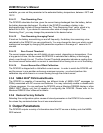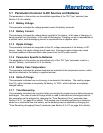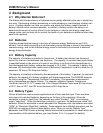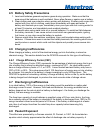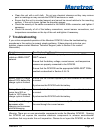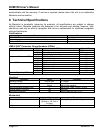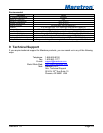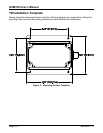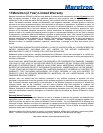
Revision 1.0 Page 11
®®
4.5 Battery Safety Precautions
1. Lead-acid batteries generate explosive gases during operation. Make sure that the
area around the batteries is well-ventilated. Never allow flames or sparks near a battery.
2. Wear clothing and eye protection when working with batteries. If battery acid comes into
contact with your skin or clothing, wash them immediately with soap and water. If
battery acid contacts your eyes, immediately rinse your eyes with cool running water for
at least 15 minutes, and immediately seek medical attention.
3. Be careful when using metal tools on or around batteries. If a metal tool falls between
the battery terminals, it can cause a short-circuit which can generate sparks, igniting
fuel fumes, or may also cause the battery to explode.
4. Remove metal items like watches, necklaces, rings, and bracelets when working with
batteries. If these items were to contact the battery terminals, the resulting short-circuit
could produce a current which could melt the objects and possibly cause severe skin
burns.
4.6 Charging Inefficiencies
When charging a battery, not all of the electrical energy put into the battery is stored as
chemical energy. This section details how the DCM100 accounts for this type of inefficiency.
4.6.1 Charge Efficiency Factor (CEF)
The Charge Efficiency Factor (CEF) represents the percentage of electrical energy that is put
into a battery that is stored as electrical energy, measured at 25°C. An ideal battery would
have a charge efficiency factor of 1.0, or 100%. A new flooded lead-acid battery may have a
CEF of 0.95, or 95%. This value means that if 100 Amp-hours of energy are put into a battery
by a charger, this results in the battery’s charge increasing by only 95 Amp-hours. The
DCM100 is capable of calculating a battery’s charge efficiency factor on the fly, as the battery
is being charged and discharged, to produce the most accurate state of charge values.
4.7 Discharging Inefficiencies
In an ideal battery, 100% of the energy in the battery would be available no matter what
discharge current is used. However, with lead-acid batteries, the energy available from a
battery depends on the rate at which a battery is discharged – the faster you discharge the
battery, the less energy is available.
The Amp-hour capacity of most batteries is specified using a 20-hour rate; that is, the Amp-
hour capacity rating of the battery is calculated if the battery is discharged from 100% to 0%
using a constant current over the period of 20 hours. If the battery is discharged at a faster
rate, then it will output less than the rated Amp-hour capacity before becoming fully
discharged.
4.8 Peukert Exponent
This effect was presented by a German scientist, W. Peukert, in 1897. He formulated an
equation which closely approximates the effect of discharge rate on battery capacity. A



